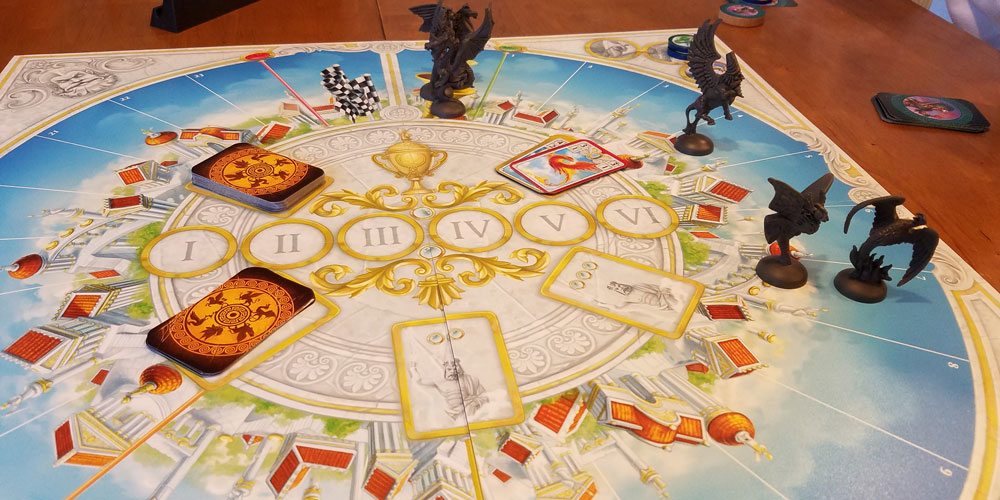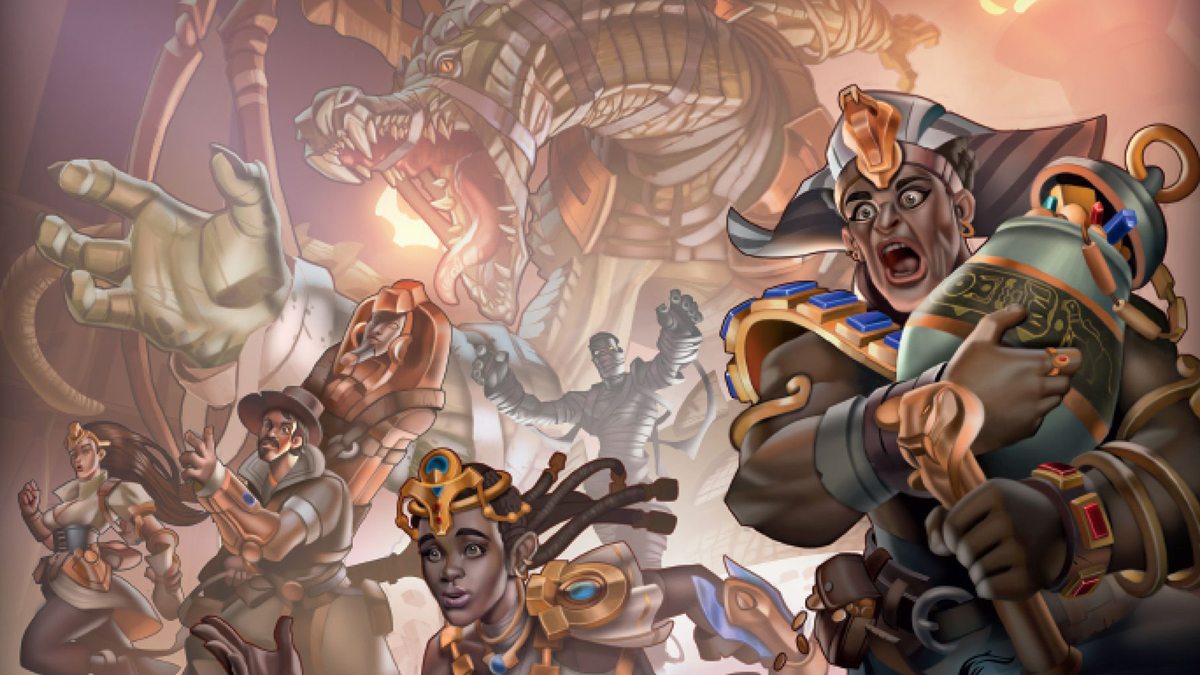
Zeus has assembled a group of gods together to see which mythical beast is best. Place your bets, then compete with the other gods to bring your beast victory.
At a glance: Divinity Derby is a betting game from Italian game company Ares. It is currently seeking funding on Kickstarter. A $35 pledge gets you a copy of the standard edition of the game and some of the stretch goals, while a pledge of $50 gets you the Deluxe edition, with upgraded components and all unlocked stretch goals. The game is for 3-6 players and takes about an hour.
New to Kickstarter? Check out our crowdfunding primer.
Note: I was sent a prototype for review purposes, but all opinions are my own. All images here are of the prototype, so the final version of the game may differ from what is shown.
Components:
- 1 board
- 6 cardholders
- 24 creature tokens
- 6 god tokens
- 1 first player token
- 6 creature miniatures. In the standard edition, they will be unpainted with colored bases, while the deluxe edition will have fully painted minis.
- 54 movement cards
- 4 Zeus protection cards
- 66 bet cards
Game play:

To set up the game, place the board in the middle of the table, and place the six creature miniatures on the starting spot. Each player chooses one of the six gods. An already-unlocked stretch goal gives each god a set of three special powers, so there are slight differences between them, but these could be ignored for beginning players who simply want to pick a god because they happen to be able to correctly pronounce Quetzalcoatl. The player takes the god token and deck of betting cards for their god. The four Zeus protection cards are placed in the first Zeus’ Judgement space on the board. The creature tokens are placed in the spots indicated on the board. Two tokens are placed for each creature in a 3 player game, three for each in a 4 or 5 player game, and all four in a 6 player game.
Cardholders equal to the number of players are placed between players, so that each player has a cardholder to his left and one to his right. Then, the movement cards are shuffled and dealt to each player: 10 each in a 3 player game, 8 in a four player game, and 6 in a five and six player game. Each player then places the cards on the cardholder to his left. This way, each player has access to two sets of shared cards. The remaining movement cards are placed in a space indicated on the board. The youngest player gets the first player token.
During the game, you’ll run three complete races. Each race is split into four phases: the first bets, the race, Zeus’ Judgement, bet outcomes, and setting up for the next race or victory point calculation.

In the first bet phase, the first player plays, face down, one of her betting cards, and then takes a creature token and places it on top of the card, thus indicating a bet on a particular creature. The betting cards range from high-risk, high-point bets like “First Place,” to lower-risk, lower-point bets like “First Place, Second Place, or Third Place.” The only real limitation here is that a player cannot place more than one bet on a single creature in any race.
Bets are made by looking at the two hands of movement cards available to you and making a guess as to how you might end up playing the cards to get the result you want. However, you have to keep in mind that each of those hands are shared by the player either to the left or the right of you, so you aren’t guaranteed to be able to play all of the cards you want. However, you can still make some good guesses: if you have a bunch of cards that move the same creature, than betting on it winning is probably safe, because even if you don’t play them, your neighbors will need to. (All movement cards get played.)
Once the first player bets, the player to her left places a bet, and so forth around the table until everyone has placed two bets. Then, the race begins.

To move the creatures, the first player takes two cards–exactly one from each of the two sets. You cannot draw two cards from the same set. Then, you can play those cards in any order you choose. Each card has two movement values–a higher number on top, the so-called “fast movement,” and a lower number (sometimes zero) below, the so-called “slow movement.” You can play two cards for the same creature, or one for one creature and another for another one. This is where a large portion of the strategy starts to come into play. Obviously, you are looking to get the result you bet on, so fast moving a creature that you bet to win, or moving other creatures in front of the one you bet to lose, will be a lot of your movement. But you also need to look at the bets your opponents made. You can see the creatures they bet on, but not the bets, so you might try to guess whether they bet on a creature to win or lose, and then intentionally play cards for that creature, even if just to deny them to your opponent (remember, at least two of your opponents are sharing cards with you.)
You can also choose to play dirty tricks. Some of the movement cards (to be exact, four for each creature) have a Dirty Trick bonus. This is one or more extra spaces the creature can move that turn. However, the dirty trick can only be played as the first movement, not the second. And, while normal movement cards are discarded to the regular discard pile, dirty tricks are placed on top of the Zeus’ Judgement pile, which means that that creature might potentially be disqualified. (More on that below.)

Once the first creature crosses the half-way point, the game temporarily pauses for a third round of betting. At this point, you can more safely play your high-risk/high-reward bets, except that the tokens for a particular creature might already be gone, and thus betting on it might not be an option. The first player token potentially moves at this point, as well, as it goes to the player to the left of the one who caused the creature to move past that half-way point. So here again is a bit of strategy–if you play a movement card that pushes the creature past the half-way mark, you are guaranteed to bet last, meaning that you will have many fewer options than the other players.
After that round of betting, the race continues until all of the movement cards have been played. In theory, creatures might cross the finish line and be placed in the final ranking track, but in the games we played we always ran out of movement cards before any creature crossed the finish line.
Once you run out of cards, all of the creatures are placed on the final ranking track in the order of their finish. Then, it’s time for Zeus’ Judgement. At this point, there’s a new stack of cards on the board–the four Zeus’ Judgement cards from setup, and any movement cards that were played as dirty tricks. These cards are picked up and shuffled, and then two are played. If the card comes up as a Zeus’ Protection, nothing happens. But, if a movement card is played, then that creature is disqualified. It is removed from the final result track, and all other creatures move up one space. This is one of the more interesting aspects of play: using the Dirty Trick may be necessary to push your favored creature ahead, but at the same time, it increases the chances it’ll get disqualified, so they need to be played with care. That is, unless you’re trying to disqualify a creature, because you think one of your opponents bet for it to win, or you yourself bet on the disqualification, because that is an option while betting.

Once Zeus has rendered his judgement, the first player reveals her bets. She takes the cards for the bets she got right under her god token to be counted as victory points at the end of the game, and takes any she got wrong and puts them in the now-vacated Zeus’ Judgement space, where they remain for the rest of the game. Herein is the final bit of strategy to consider: win or lose, you can only use each betting card once in the game.
Finally, in the first and second races, you reset the board by placing the creatures back in the starting space, putting the four Zeus’ Protection cards in the second or third space, putting all of the creature tokens back on their spaces on the board, and reshuffling all of the movement cards and redealing the correct number to the players. The first player token moves to the next player on the left (remember, it might have moved in the third round of betting), and that player begins the first betting round for the next race.
After the third race ends and bets are revealed, all players count up the victory points from their successful bets, and the one with the most points wins.
The verdict:
When I first read through the rules, I thought the game was going to be a mythology-based take on Camel Up. That wouldn’t have been bad, as in addition to being a Spiel des Jahres winner, Camel Up is one of my favorite games. But it turns out that isn’t an apt comparison at all. Divinity Derby has considerably more strategy than Camel Up, since the movement isn’t determined by the luck of dice, but rather by tactical play of cards. (Although there is still a luck component, since you don’t have access to every card in the deck.) This added level of control, along with the other strategic elements in the game such as deciding when to play the Dirty Tricks and when to try to play cards just to deny them to your opponents, gives Divinity Derby much deeper game play than it appears to have at first glance.

The game is also very nicely designed. Even the prototype has excellent artwork, and I look forward to seeing what the final creature miniatures look like. Given that Ares is responsible for Sails of Glory and its absolutely gorgeous sailing ship miniatures, I have no doubt that these will be beautiful as well.
The game has already marched well past 300% of its funding goal, and is quickly approaching its final stretch goal (the addition of the Flying Spaghetti Monster as one of the playable gods), and it’s produced by a company with a proven track record of delivering on Kickstarter projects, so you can add your pledge now with a good deal of confidence that you will get to eventually enjoy this game. And I can say with equal confidence that it’s a game you will end up enjoying.



